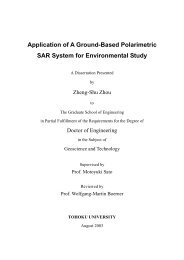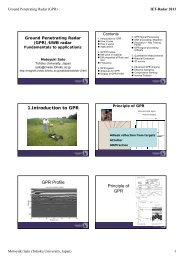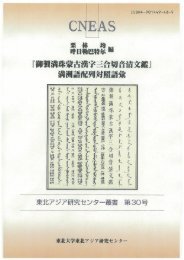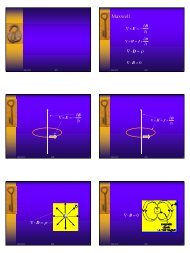Chapter 3: Vehicle-Mounted GPR System for Landmine Detection
Chapter 3: Vehicle-Mounted GPR System for Landmine Detection
Chapter 3: Vehicle-Mounted GPR System for Landmine Detection
You also want an ePaper? Increase the reach of your titles
YUMPU automatically turns print PDFs into web optimized ePapers that Google loves.
3.4 Quick <strong>Detection</strong> Algorithm 39<br />
1 z′+<br />
w 2<br />
e( r′ ) = dze( )<br />
w<br />
∫ r (3.11)<br />
z′−w<br />
2<br />
The appropriate window width may depend on the wavelength of the system, and<br />
the most effective width is a semi-period of a trace. The data are normalized by the<br />
maximum value in each depth slice, and summed values with respect to depth are<br />
projected to a map.<br />
pxy ( , ) = ∫ dz<br />
e () r<br />
max ( )<br />
xy ,<br />
[ e r ]<br />
(3.12)<br />
In the actual demining test <strong>for</strong> a sensor, detected targets are rated with the<br />
confidence. The confidence rating is defined as shown in Table 3.2. To calculate the<br />
confidence ratings, the map p( xy , ) is normalized again and is thresholded.<br />
xy ,<br />
( , ) − min [ pxy ( , )]<br />
xy ,<br />
[ p xy] − [ pxy]<br />
pxy<br />
pxy ˆ( , ) =<br />
max ( , ) min ( , )<br />
xy ,<br />
⎧ 0 0 ≤ p( xy , ) ≤th1<br />
⎪<br />
25 th1 < p( x, y)<br />
≤th2<br />
⎪<br />
prate( xy , ) = ⎨ 50 th2 < pxy ( , ) ≤th3<br />
⎪ 70 th3 < p( x, y)<br />
≤ th4<br />
⎪<br />
⎪ ⎩100 th4<br />
< p( x, y) ≤1<br />
(3.13)<br />
(3.14)<br />
The four thresholds should be defined by analyzing the stochastic distribution of<br />
p( xy. , )<br />
This algorithm is not a trace-by-trace process, because the algorithm uses the<br />
migrated data and the normalization in Eq. (3.12) is taken in a two-dimensional<br />
space. Thus, the rating in Eq. (3.14) is not an absolute evaluation. It compares the<br />
energy of the trace with neighboring ones meaning a relative evaluation. If the<br />
ground surface is relatively flat and no large terrain changes, this algorithm might<br />
work well. If not, it however could output errors.








